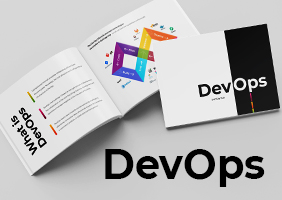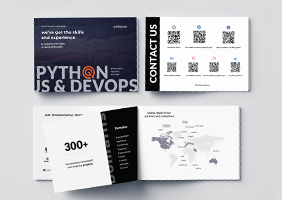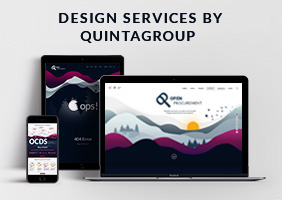By and large, currently the notion of DevOps Services embraces a wide range of practices, each particular case depending on the customer’s requirements and needs. At Quintagroup, among others, we offer CI/CD services employing such tools as Jenkins, Travis, and Buildbot, Automatic Deployment services with Docker and Ansible, environment installation with Terraform and configuration including both on-premises and cloud-based services using such systems as AWS and Microsoft Azure.

Other most common DevOps practices also include:
- Infrastructure Creation
- Environment Configuration and Optimization
- Security Management
- Automated Testing
- Automated Deployment in Testing/Production Environment
- Release Management (and Version Control)
- Performance Monitoring (real-time, historical, alerting, error-handling)
- Load Testing
Continuous integration (CI)
Continuous deployment (CD)
Infrastructure as a code (IaC)
Configuration management
Release management
Continuous Monitoring (CM)
DevSecOps
Infrastructure Automation and Orchestration
Cloud adoption
Containerisation / Kubernetes
CI/CD
Continuous Integration and Continuous Delivery nowadays are widely known to be the inevitable parts of software development process ensuring smooth running and fast product implementation. The term Continuous Delivery applies to a software engineering approach consisting in producing a software product in short cycles. As its vital stage, Continuous Integration is a practice of merging each developer’s copies of their code to a single shared mainline while working on a joint project with the aim to avoid the problem commonly known as “integration hell”.
Due to frequent code integrations, bugs can be detected early and fixed easily meaning less efforts and time to be spent on emerging tasks. In combination with automated unit quality control tests, it results in constant software features improvement following the reduction in time to deliver the product. The culture of recurring code check-ins within the developers' community brings forth the habit to create modular and less complex code, the discipline of regular automated testing and helps to prevent last-minute chaos at product release dates.
The most common tools employed in DevOps practices at Quintagroup serving the purposes of infrastructure creation, configuration, and management, its security and control, automatization and streamlining of processes are Terraform, Ansible, and Docker.
Download the brochure to learn more
TERRAFORM
Terraform is a tool helping to build, modify and version the infrastructure when working in the cloud and applying the “Infrastructure as Code” principle. The key features of this instrument include:
- execution planning to avoid unexpected situations in manipulations with infrastructure, incorporating the resource scheduling function allowing to manage the assignment of applications to machines dynamically;
- resource graph builder providing deep insights into infrastructure dependencies, and providing complex changesets requiring minimal human intervention in combination with execution planning;
- building and managing multi-tier infrastructure;
- building and scaling service for self-management by the product teams by codifying this option in a configuration;
- possibility to furnish the configurations allowing to create and bootstrap testing environment on cloud and, in addition, to share production environment configurations with the staging, enabling to spin up and dispose of testing environments quickly;
- support of multi-cloud deployment meaning a single configuration can be used for managing different cloud providers, giving the opportunity for cross-cloud dependencies handling and increasing fault-tolerance with a refined loss recovery, all this resulting in simplified orchestration.
ANSIBLE
The main function of this tool is to automate repetitive procedures in the DevOps workflow and describe the infrastructure settings. It provides a number of benefits considerably speeding up and improving the quality of work we do:
- It’s an open-source tool which is being continuously developed due to daily contributions from several thousand-community;
- It uses simple human-readable automation language close to plain English for describing an IT infrastructure comprehensible even for non-tech users, therefore being very easy to learn and requiring no special coding skills, as a result;
- Has agentless architecture enabling effortless deployments with the possibility of complete automation of the whole application lifecycle and Continuous Delivery pipeline;
- It ensures the interrelation of all the systems due to the possibility to set the IT infrastructure in multi-tier deployment mode;
- It’s powerful enough to handle a great number of DevOps processes such as software deployment, configuration management, workflow orchestration, continuous delivery process, security and compliance with additional support of various integrations to administer infrastructure and networks, work with containers, provision cloud infrastructures and automate across the development, testing, deployment and monitoring/analytic tools to embrace the whole system;
- It helps to enhance a team’s productivity and collaboration, save time, avoid man-made errors, reduce drudgery by providing the automatization of cloud provisioning, configuration management, application deployment, intra-service orchestration.
DOCKER
Containers are portable and lightweight packages of the software comprising code and all its dependencies as an isolated image, standardized application that can be run very quickly but reliably in any computing environment with no regard to their differences. This technology helps to considerably reduce the infrastructure and maintenance costs by saving DevOps time and efforts in CI/CD workflow and can boast a number of advantages:
- More time to focus on new applications and services by containerization of applications which takes up less space than virtual machines can handle more applications and requires fewer VMs and OSs;
- Enhanced developer productivity for no need of setting up dev environments over and over that speeds up code delivery;
- Increased deployment frequency resulting in faster and higher-quality delivery;
- Efficient resource utilization by means of increased application workload density and improved use of server compute density;
- Simplification of the supply chain by automation of various application management with the help of a uniform operating model;
- Painless rollbacks and fixes deployment to applications bringing more customer satisfaction and advanced service level.
At Quintagroup we are doing our best to save our customers time and costs while increasing the quality standards endlessly. We utilize the best open source technologies operated by highly-qualified Python-literate specialists that add value to our services and greatly contribute to customer satisfaction. Feel free to use this form to get a quote.



